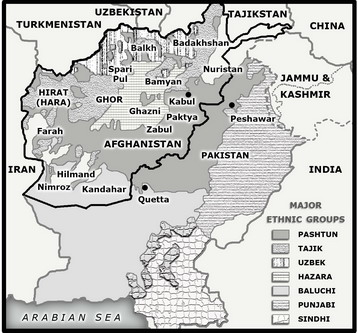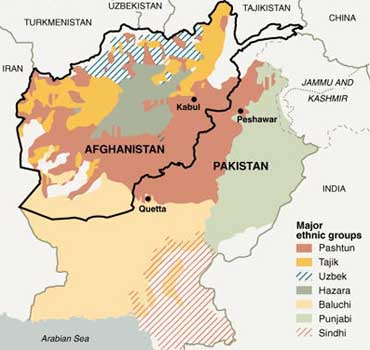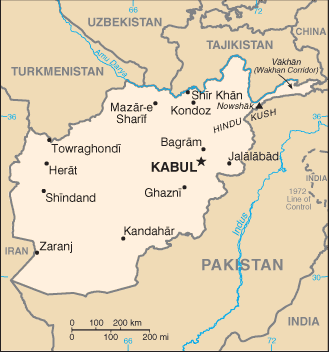Brit-Am
Replies to Queries

Afghanistan and Israel
Brit-Am
Replies to Queries

Questions
and Answers
| Tartan from Canaan | |

|
Map showing the Ethnic Divisions of Afghanistan and Pakistan. Pashtun is another term for Pathan. The Map was prepared by Estelle Schutte for our work "The Khazars. Tribe 13". This work, "The Khazars. Tribe 13" published by Brit-Am, the Lost Ten Tribes of Israel Movement, contains much additional material concerning the Afghans and proves that they are not of Israelite origin. |
"Hara" was much further to the east in the region straddling the borders of present day Iran and Afghanistan. "Hara" encompassed places named Aria, Ariana, and Arachosia, by the Greeks10. "Hara" was called "Haraiva" and "Hare" by the Persians11, and known under its correct name "Hara" to the Medes12, just as it is still called "Hara" by the locals today13. It is crossed by the Hari Rud or "River of Hara" and contains the city of Harat.
The Assyrians ruled the Hara area and all of the surrounding region and settled a portion of the Israelite tribes there in, specifically part of those tribes from east of the Jordan: Rueben, Gad, and half Manasseh, since only concerning their exile is the name "Hara" mentioned:
THE GOD OF ISRAEL STIRRED UP THE SPIRIT OF PUL KING OF ASSYRIA, AND THE SPIRIT OF TIGLATH-PILNESER OF ASSYRIA, AND HE CARRIED THEM AWAY, EVEN THE REUBENI, AND THE GADI, AND THE HALF TRIBE OF MENASSEH, AND BROUGHT THEM UNTO HALA, AND HABOR, AND HARA, AND TO THE RIVER OF GOZAN UNTO THIS DAY
(1-Chronicles 5;26).
Assyrian control of the Hara area is proven by inscribed claims of Assyrian monarchs to have received tribute from Magan and Meluhha which nations (in neo-Assyrian nomenclature) were either by the Indus delta or to the east of it14. Hara adjoined Bactria and Roman and other accounts related that the Assyrian Semiramis (wife or widow of "Pul"-[i]): had conquered Bactria to the north of Hara as well as parts of India to its east15. The Assyrians sent frequent expeditions to Mount "Bikni" meaning the "Mount of Lapis Lazuli" and most (if not all) the lapis lazuli of Assyria came from Badakhshan to the northeast of "Hara"16. According to Greek and Iranian sources the Assyrians had planted colonies in the region of Kabul and Gandhara to the east of Hara17. Indian scripts also recall the "Asurya" with their god "Asura" (meaning the Assyrians with their deity "Ashur") who had colonies in Hara and Sakastan18. Assyrian cultural influences in this area and cultural influences from this area on Assyria confirm the Assyrian presence in this region19.
According to local tradition the eastern part of Hara ("Ghor"), where the Hari River rises, was once settled by a people referred to as "Assakan" and "Bnei Yisral" or Children of Israel20. "Assakan" was shortened to "Sak" or "Sok" and local Muslim lore equated the term with the name "Isaac", father of Israel21. A dialectical variation of "Assakan" is Afghan22 and the names "Bnei Yisral" and "Afghan" were applied later to a group from Armenia who settled in the area after the original "Bnei Yisral" and "Assakan" had moved out23. The newcomers eventually moved further east into modern Afghanistan. They did not apply the names "Afghan" and "Bnei Yisral" unto themselves until fairly recently and then only within a few literary circles24. Some Israelite and/or Jewish elements may have been absorbed amongst one or two of the various "Afghan" groups and these in turn influenced the whole. The Royal family, for instance, had a tradition that they descended from the Tribe of Benjamin25. Even so, most Afghans never seem to have identified themselves as Israelites and are antipathetic to the very idea. They are the first to admit that the names "Afghan" and "Bnei Yisral" were first applied to them by foreigners26. By their own admission they received these names from other peoples. They themselves say that they received the names due to the original holders of these names having moved out of the area that they came to occupy. The existence of these names is evidence that a section of the Israelite nation had once been in that area. The original dwellers are apparently to be identified with the historical "Sok" or "Sakae" (meaning Scythians) who were in the Hara region at least from around 600 BCE 27 or earlier. They had been settled there by the Assyrians, and had a tradition that King Solomon of Israel had once ruled over them28. From the Saka descend the Anglo-Saxon invaders of Britain.
In Scythia Ptolemy placed the ASPASSI Scythae to the north of the Iatii and Augali and the Chorasmii to their southeast. ...The Massagetae (according to Ptolemy) had two sections, one in Margiana and another further east in the Sacae domain beyond the Jaxartes River. As for the Aspassi, they historically were to be connected with the Parthians who were also known as "Ashakens" and similar denominations. A similarly named people were to the east of Hara, in the region of the Kophen (Kabul in present-day Afghanistan) where the "Assakenoi" or "Assaka" were to be found. These were a part of the Sacae and were named after Isaac.
The Assakenoi were either identical with, or close neighbors of the "Aspioi" or "Aspaganoi" whose name was also to be rendered as "Isap" and "Ysuf-zi" meaning "Tribe of Joseph". In other words in both Kabul (Afghanistan) and in North Scythia were neighboring peoples who bore names with the roots Ask and Asep. Scythian peoples bearing names with the root Asc, Asek, Sak, etc. are fairly common and appear to be so called since they had once belonged to the "House of Isaac". Likewise, the Yasubi, Yasubgalli, Aspaganoi, Aspassi, Aspacarae, Suefs, Suobeni, all appear to have belonged to Scythian peoples, and all have names somehow connected to the same word root and probably received their appellations since they belonged to the tribe of JOSEPH.
"in both the Aspassi-and-Augalli region and by Gandhara were the THATAGYDES (Sattaguda) believed to be a combination of Thata and Goths".
Later, in the eastern Iranian area close to the Indus were the people of "Asapioi" who were also to be called "Isapoi" and "Ysufzi" meaning JOSEPH4. These names (like all those of Afghanistan see Bellew) were later to be applied to other different peoples. The root "ASAP" in the Hebrew Scriptures is related to the birth of Joseph: "And she [i.e. Rachel] conceived, and bare a son; and said God hath taken away [in Hebrew: "ASAPH"] my reproach: And she called his name Joseph", Genesis 30:23-24). The name Joseph in the Iranian-Afghan region was renderable as "Jo-asaph"5 and at all events "ASAP" is a derivative in Semitic regions of Joseph6. Other Scythian peoples such as the Aspassi in Chorasmia and the Aspacarae (whose names bear the "ASP" root) in Serica were also descended from Joseph. The Aspacarae of Serica were identical to the Eastern-Sienbi or Suebi and in western Europe are sometimes referred to as SWEAF and represented by the eponymous figure of Svipdag. The Sweaf-Sienbi participated in the Anglo-Saxon invasions of Britain.

|
The Royal Family may have had a tradition that they descend from Benjamin but this does not make it genuine and also does not apply to the rest of the population.
During the Second World War the reigning monarch of Afghanistan along with other members of the elite
adopted Nazi ideaology. They attacked the local Jewish population and had to be deposed by the British who at that time ruled over
the adjoining regions. The article goes on to describe Afghan customs that are similar to Israelite or Jewish ones. |
Bani-Israelite Theory of Paktoons Ethnic Origin
http://www.afghanology.com/BaniIsraeli.html
Extracts:
In consonance with political hostility between Mughals and Pakhtoons, there also existed a deep cultural bias between the two rivals. The two sides didn't spare any opportunity of letting each other down, so more true of Mughals. The story goes, and it also has been recorded in "Makhzan-i-Afghani", that one day Khan Jehan Lodhi was attending the court of the Mughal Emperor Jehangir, when an Iranian emissary passed a very derogatory remark about the origin of Pakhtoons to appease Jehangir. Hurt by the remark, Khan Jehan was prompted to have Pakhtoon history compiled by his subordinates, Haibat Khan Kakar, Hamza Khan Tokhi, Zarif Khan Yousafzai, and Nematullah Harvi. As Mughals, the rivals of Pakhtoons, were claiming racial supremacy through descend from "Yafs" son of "Noah", the compilers of Makhzan strove to prove Pakhtoons Israelites for ethnic superiority over Mughals and so came up with Makhzan-i-Afghani. Later Pakhtoon historiographers quoted heavily from Makhzan-i-Afghani because of its being the only written source about the origin of Pakhtoons.
Thus the Israelitish theory of Pakhtoon origin not only was accentuated but also turned into a tradition. The theory was current till the beginning of the 20th century when it came under severe criticism from scholars for a number of reasons; mainly for its contradictions with Hebrew Scriptures, its historical inconsistencies, and the linguistic characteristics of Pashtu that classify it an Aryan Language instead of Semitic. The Bani-Israelite theory, and correspondingly Makhzan-i-Afghani, have degraded to a fairy-tale in their worth as a plausible interpretation of Pakhtoon origin as a result of the research of the 20th century. Makhzan-i-Afghani, however, has retained its significance as a good source of information about the genealogical and tribal constitution of Pakhtoon society.
Political Dimension of Bani-Israelite Theory:
Interestingly, in its own time, the authenticity of Makhzan-i-Afghani had been questioned by the people now projecting it as a propaganda tool because it gave Pakhtoons a superior status by declaring them as the descendents of prophets. Pakistani government helped propagate it to emphasize Pakhtoons as a people of faith and so to help strengthen Pakhtoons bond with Islamic ideology of Pakistan vis-a-vis the infidel India. Now that the Bani-Israelite theory about Pakhtoon origin has been scientifically proved untenable, people initially objecting to it have reverted to the opposite viewpoint of its being authentic for political motives to dub Pakhtoons a sort of foreigners in their historical land.
Inconsistencies of Bani-Israelite Theory rendered By Makhzan:
Makhzan traces Pakhtoon's origin from the super-Patriach Abraham down to one named King Talut or King Saul. The description of Makhzan to this point agrees to a certain degree to the testimony provided by Muslim sources or Hebrew Scriptures, which affirm the existence of King Saul around B.C. 1092 in Palestine. It is actually beyond this point that the authenticity of the description comes under serious doubt.
Makhzan-i-Afgani further maintains that Saul had a son Irmia(Jeremia) who again had a son called Afghana raised by King David upon the death of King Saul and later promoted to the chief command of the Army during the reign of King Solomon. Fortunately or unfortunately, there is no evidence to the existence of characters like Irmia or Afghana in Herbew Scriptures or to the events associated with these characters.
The description then makes a sudden jump to 6th century B.C. when Bakhtunnasar or Nebuchadnezzar king of Babul attacked Judah and exiled Bani-Israel, the progeny of Afghana, to Ghor in Afghanistan. Here arises a great contradiction with what the Herbew Scriptures state. According to Scriptures, Nebuchadnezzar brought Jews in captivity to Babul where they remained till Cyrus, the King of Persia from B.C. 550 to B.C. 529, attacked Babul, freed Jews of captivity, and allowed them to return to Jerusalem. Herbew Scriptures praise Cyrus greatly for this favor. So, Cyrus didn't send the Jews captives to Ghor but rather to Jeruslem.
There is one other inconsistency here and that is the failure of Makhzan-i-Afghani to differentiate between Judah and Bani-Israel. This inconsistency has crept in because Makhzan has copied the tale of Jewish captivity from Muslim sources and Muslim sources weren't well acquainted with Jewish history. In fact, after Solomon, around B.C. 900, Jewish Kingdom had split into two states, one Samara controlled by two tribes of Judah and the other Jeruslem ruled by ten tribes of Bani-Israel. Before the attack of Nebuchadnezzar on Judah, the Assyrian king Shalmaneser had raided the Bani-Israelites state in B.C. 721 and sent the ten Bani-Israelite tribes in exile to Media, the North-Western part of today's Iran. It is these ten tribes which the Herbew historians have mentioned to have been lost and not the two tribes of Judah exiled by Nebuchadnezzar to Babul around B.C. 580 but allowed by Cyrus to return to Jeruslem. The Persian Empire didn't exist at the time of first Jewish captivity(B.C. 721) and had been founded later by Cyrus in B.C. 550. Plausibly the ten exiled tribes mingled with the local population of Media or dispersed over to Russia and Eastern Europe. Whatever, these contradictions cost serious doubts on the Makhzan account of Jewish captivity and so undermines its authenticity.
There are numerous other inconsistencies in Makhzan. For example its account of the conversion of the Pakhtoons to Islam in entirety under the spiritual guidance of the mythical character Qais-Abdul-Rashid who, as Makhzan informs, paid pilgrimage to Madina, embraced Islam at the hands of the Prophet(PBUH) himself and then returned to Ghor to have the whole of Pakhtoon people converted to Islam is neither testified by Islamic tradition nor history. Rather, historians have recorded the existence of infidel Pakhtoons at a period as later as 11th century A.D. Moreover, Makhzan states Khalid bin Walid to be a kinsman of Pakhtoons who sent Pakhtoons, in waiting for the new prophet to appear, about the advent of Islam. There is no reference to this fact in any source whether Islamic or Arab. Historians rather have stated Khalid bin Walid to be a respectable member of the Kuresh tribe.

|
Source: "Jews in Afghanistan" by Aleza Goldsmith /Jewish Bulletin of Northern California Jewsweek.com | While most Taliban extremists have never even seen a Jew, Afghanistan was, not so long ago, home to a thriving Jewish community. As recently as the beginning of the 20th century, more than 40,000 Jews actually lived there quite peacefully, says Ken Blady, a Jewish educator, writer and lecturer on the subject of Jews in remote areas of the world. |
|
Yet today, says the Berkeley resident and author
of Jewish Communities in Exotic Places, there is
"not a single Jewish person left there that we
know of." By the time the Taliban rose to power in
the mid 1990s, the land of Afghanistan -- which
once provided immunity for Jews from the Shiite
Muslims of Persia -- was pretty much devoid of
Jews.
When Genghis Khan invaded Afghanistan in the early 1200s and "totally demolished what was an advanced country with prestigious and liberal universities," he also wiped out a large percentage of the Jewish people there. But they later began trickling back in, especially in the 1800s when the Shiites began to forcibly convert them. "In Persia they had a choice between the sword or conversion to Islam," says Blady. "Afghanistan was not quite as intolerant. Jews...were not allowed to be forcibly converted." Jews, along with Christians and Zoroastrians, however, were to be constantly reminded of their inferiority. They were not allowed to build a synagogue that was higher than a mosque and they could not ride on horses, "which were reserved for higher castes." Most Jews worked in crafts, dyeing carpets, or as peddlers, importers and exporters. "They had a rigid place in society and were generally protected by the law. Just as you wouldn't kick your dog, you wouldn't kick a Jew." With the Jews' early and long connection to Afghanistan, it is not wholly surprising that British colonists once pointed out "something unusually Jewish about Afghans," says Blady. "They wore earlocks and shawls, and it is even claimed that they lit candles on Friday nights." But despite this amalgamation of Jewish tradition, Blady says the claim of some Muslim Afghan tribes that they are descended from the Ten Lost Tribes is a false one. The Pashtun people, of which the Taliban are a part, for instance, claim they were Jews who converted to Islam under the advice of another Jewish convert to Islam, a disciple of Muhammad, during the eighth century, he says. They claim that the city of Kabul "stands for Cain and Abel" and that the name Afghanistan is derived from the grandson of King Saul of the tribe of Benjamin, Afghana. Blady calls this mythology. "They are Aryan, Kurdish, Iranian people, not Semitic at all," he says. They created this mythology about themselves in order to lord it over people -- to say, when all else was primitive and barbaric, they were already monotheistic." Blady says this Aryan descent is partly why the Nazis tried to establish solidarity with the Afghans during World War II. "They began dropping leaflets from the skies to establish hatred and tension towards the Jews." Many were killed in massacres. Others fled to Bombay, pre-state Israel, Italy, England and America with the help of various Jewish organizations. The few hundreds of Jews remaining in Afghanistan after the war left when the Soviets invaded in 1979. "By the time the Taliban came to power there was only one Jewish family left. Then, about two years ago, they also managed to leave." |
Join the Brit-Am Ephraimite
Discussion Group
Just Send an
e-mail
with "Subscribe"
in the Subject Line
Main Page
Offerings and Publications
Return to Question and Answer
Table of Contents